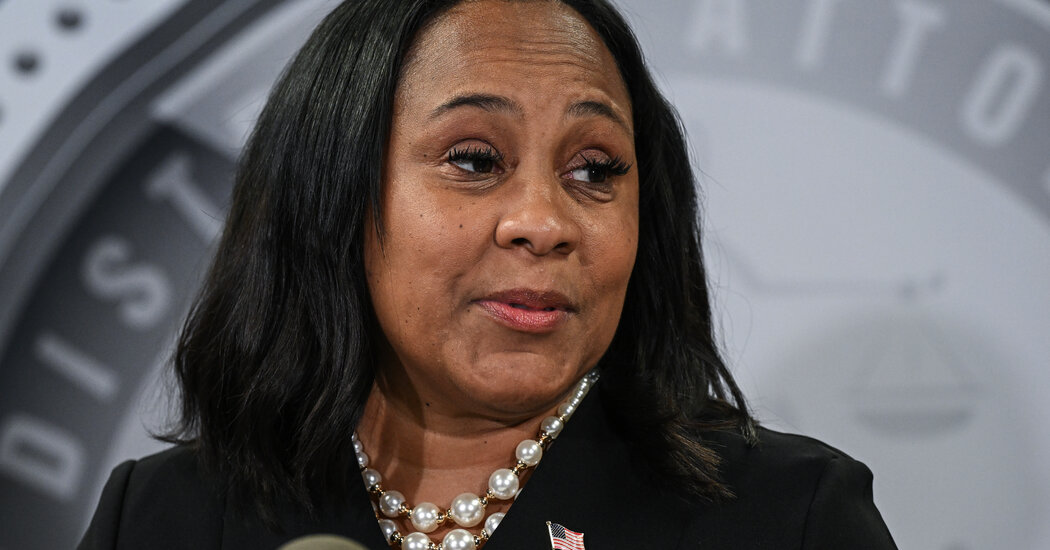Authorities Investigate Virginia Plane Crash That Followed D.C. Sonic Boom
Federal authorities on Monday were investigating what caused an unresponsive private aircraft to fly over Washington, D.C., on Sunday, triggering a response by military jets that caused a sonic boom to be heard across much of the region before the small plane crashed in Virginia, killing all four people onboard.
The private business jet went down near Montebello, Va., the National Transportation Safety Board said. A spokeswoman for the Virginia State Police said in a statement on Monday that emergency responders were able to reach the wreckage on foot about four hours after receiving a report of a plane crash.
John Rumpel, who runs Encore Motors of Melbourne, a Florida-based company that owns the aircraft, said in a telephone interview on Monday that his daughter, Adina Azarian; his 2-year-old granddaughter; her nanny and the pilot were on the plane and did not survive.
The plane, a Cessna 560 Citation V, crashed “almost straight down and at a high speed,” he said, adding that the impact caused a crater, and the wreckage was spread over 150 yards. Mr. Rumpel had said on Sunday that they were returning home to East Hampton, N.Y., after a four-day visit to his home in North Carolina.
Investigators were left on Monday to piece together what went awry with the flight, which had taken off from Elizabethton Municipal Airport in Elizabethton, Tenn., around 1:15 p.m. and was bound for Long Island MacArthur Airport in Ronkonkoma, N.Y.
Fifteen minutes after taking off, the pilot was given a command from air traffic control to level off at 31,000 feet but did not respond, said Eric Weiss, a spokesman for the N.T.S.B. Instead, the plane continued to climb until it reached a cruising altitude of 34,000 feet, he said.
After reaching Long Island, the plane did not make an attempt to land but instead turned around and headed back in the direction of where it had originally taken off, according to the flight tracking website FlightAware.
With the plane’s pilot unresponsive, six F-16s were scrambled from bases in Maryland, New Jersey and South Carolina, said Michael Dougherty, a spokesman for the North American Aerospace Defense Command, or NORAD.
Two F-16s from Joint Base Andrews in Maryland made the initial contact with the plane, Mr. Dougherty said. For half an hour, he said, the F-16s used a combination of maneuvers and flares in an unsuccessful attempt to get the pilot’s attention.
The pilots who “visually inspected the Cessna” while it was in flight confirmed that the pilot of the private aircraft was unresponsive and “slumped over,” said Capt. Alexandra Hejduk, a NORAD spokeswoman and member of the Canadian military.
In a statement on Sunday, NORAD said that fighter jets responding to the unresponsive plane had been “authorized to travel at supersonic speeds,” which would have produced the boom that was heard in the region, including in the suburbs of Virginia and Maryland.
Officials determined that the Cessna did not pose a threat, and it crashed in Virginia around 3:30 p.m., according to the Federal Aviation Administration. It was not shot down, officials said. A White House official said President Biden was briefed on the incident.
Adam Gerhardt, an N.T.S.B. investigator, told reporters on Monday that the agency would be on the ground for at least three to four days. He said the wreckage was “highly fragmented,” and he described the area as rural and mountainous.
“It will be a very challenging accident site,” he said.
Mr. Gerhardt said it was not yet known if the plane had a cockpit voice recorder or a flight data recorder, though he said the aircraft was not required to have such equipment.
Mr. Weiss, the N.T.S.B. spokesman, said one possibility that the agency planned to examine was whether the plane might have lost cabin pressure, resulting in hypoxia, or oxygen deprivation, for those on board.
Mr. Rumpel, who is also a pilot, said on Sunday that he had little information about the circumstances of the crash, but hoped his daughter, granddaughter and the others on board had not suffered. His voice breaking, he said that if the plane lost pressurization, “they all just would have gone to sleep and never woke up.”
“It descended at 20,000 feet a minute, and nobody could survive a crash from that speed,” Mr. Rumpel said.
Ms. Azarian, 49, worked as an agent for Keller Williams, the real estate company, in New York City and on Long Island. The company said in a message to colleagues that her death was a “profound loss.”
On Sunday, people reported on social media that they had heard a loud boom across the Washington area. Many said the noise sounded like an explosion, and some said the boom was so strong that it shook their homes. A sonic boom is caused by an object moving faster than sound, or about 750 miles per hour at sea level.
Rafael Olivieri, 62, said he was at home in Annandale, Va., when he heard a “loud, very short sound” that shook his house. Mr. Olivieri ran outside, where his neighbors were also trying to figure out what had happened. “My first thing was looking to the sky,” he said. “I was really worried.”
More than 30 miles northeast, in Edgewater, Md., Joseph Krygiel, 47, also felt the boom. He said he was in his basement just after 3 p.m. when the whole house shook. “It felt like something major,” Mr. Krygiel said.
Amanda Holpuch, Derrick Bryson Taylor and Eric Schmitt contributed reporting.


